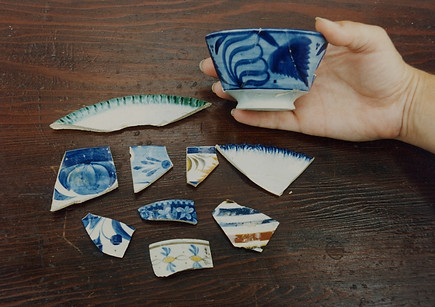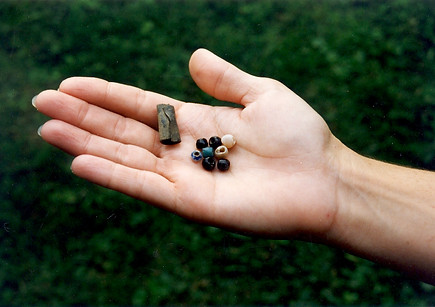The 1995 Excavations at New Salem: Two Forgotten Households
In 1994, two new sites were discovered within the limits of Lincoln’s New Salem Site Historic Site that had not been examined during the 1930s archaeology and replica construction at the park. In 1995, SAC crews began test excavations at these sites (Area CC and Area AA), which were the first archeological investigations at the historic park in nearly 50 years.

The two otherwise undocumented structures at Area CC and Area AA, as depicted on R.J. Onstot's bird's eye view of New Salem.

A pit used in hog butchering, at Area CC.

British pearlware found at Area CC.
Only a single known paper document places buildings in this portion of the village. On a birds-eye view drawing of New Salem made by Reverdy J. Onstot, two structures are depicted in roughly the same location as the artifact scatters found in 1994. Onstot had lived at New Salem as a small boy and probably created this map during the late 19th century with the help of other surviving former residents. Both sites are now believed to have been settled just prior to the founding of the town of New Salem in the fall of 1829.
The work at Area CC encountered a series of pits (used to store vegetables and to butcher hogs) in the corner of what was a fenced yard. That yard was affiliated with a small dwelling now thought to have been built by storekeepers Samuel Hill and John McNamar in the summer of 1829, or just before town was platted. When the pits were no longer needed, they were filled with topsoil and debris from the storekeepers’ home and their nearby store.
Area AA was found to date even earlier – perhaps around 1825 – and included several large pit features and the well-preserved remains of an earthen-floored outbuilding. That building probably served as a still house, where grain alcohol was made. On floor of the building could be seen the long, linear impressions left behind by puncheon logs that had been laid across the dirt surface.
In addition to a large sample of British pearlware from a nearby dwelling, the excavations at Area AA also produced a number of glass trade beads, shell “wampum”, and a rolled brass hair ornament. Probably lost by visiting members of the Potawatomi Tribe (who still hunted the Sangamon Valley during the mid-1820s), these items represent some of the latest reflections of Indigenous cultural presence in the region.
A detailed overview of the discovery and excavation of these sites is included in Mazrim’s 2007 book, The Sangamo Frontier: Archaeology in the Shadow of Abraham Lincoln, published by the University of Chicago Press.

Plan view of earthen-floored stillhouse at Area AA.
